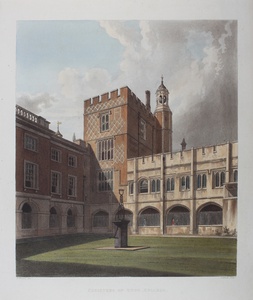| Method | Aquatint with hand colouring |
| Artist | John Bluck after William Westall |
| Published | London: Pubd. May 1. 1816, at 101 Strand for R. Ackermann's History of Eton College. |
| Dimensions | Image 247 x 214 mm, Plate 300 x 252 mm, Sheet 335 x 265 mm. |
| Notes |
From Rudolph Ackermann's A History of Eton College. Rudolph Ackermann (1764 - 1834) was a lithographer and publisher born in Saxony. He moved to London in 1787 and later established a business as a coachmaker at 7 Little Russell Street, Covent Garden. In 1796, having already published the first of many books of carriage designs, he moved to 96 Strand where he ran a drawing school for ten years. The following year, Ackermann moved to 101 Strand (known, from 1798, as The Repository of Arts) where he sold old master paintings and artists' supplies as well as prints. In 1803, 220 Strand was given as his address in a print published that year. The Microcosm of London (1808-10) and the monthly Repository of Arts (1809-29) established his reputation for fine colour plate books. From 1816, he began to publish lithographs. Ackermann always maintained links with his native Germany, and in the 1820s, he also opened outlets in Mexico, Guatemala, Colombia, Argentina, and Peru. In 1832, he handed the running of the business over to his second son George and his younger brothers, who traded as Ackermann & Co.at 106 The Strand until 1861. Ackermann also established a print business for his eldest son Rudolph at 191 Regent Street. John Bluck (1791 - 1832) was a British printmaker and engraver, specialising in aquatint. William Westall (1781 - 1850) was a British topographical draughtsman and engraver. He became an Associate Member of the Royal Academy in 1812. He was the younger brother of the painter and illustrator Richard Westall. Condition: Good impression, slight fading to text on lower margin, trimmed within plate mark on top right margin. |
| Framing | unmounted |
| Price | £120.00 |
| Stock ID | 43859 |

